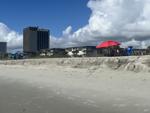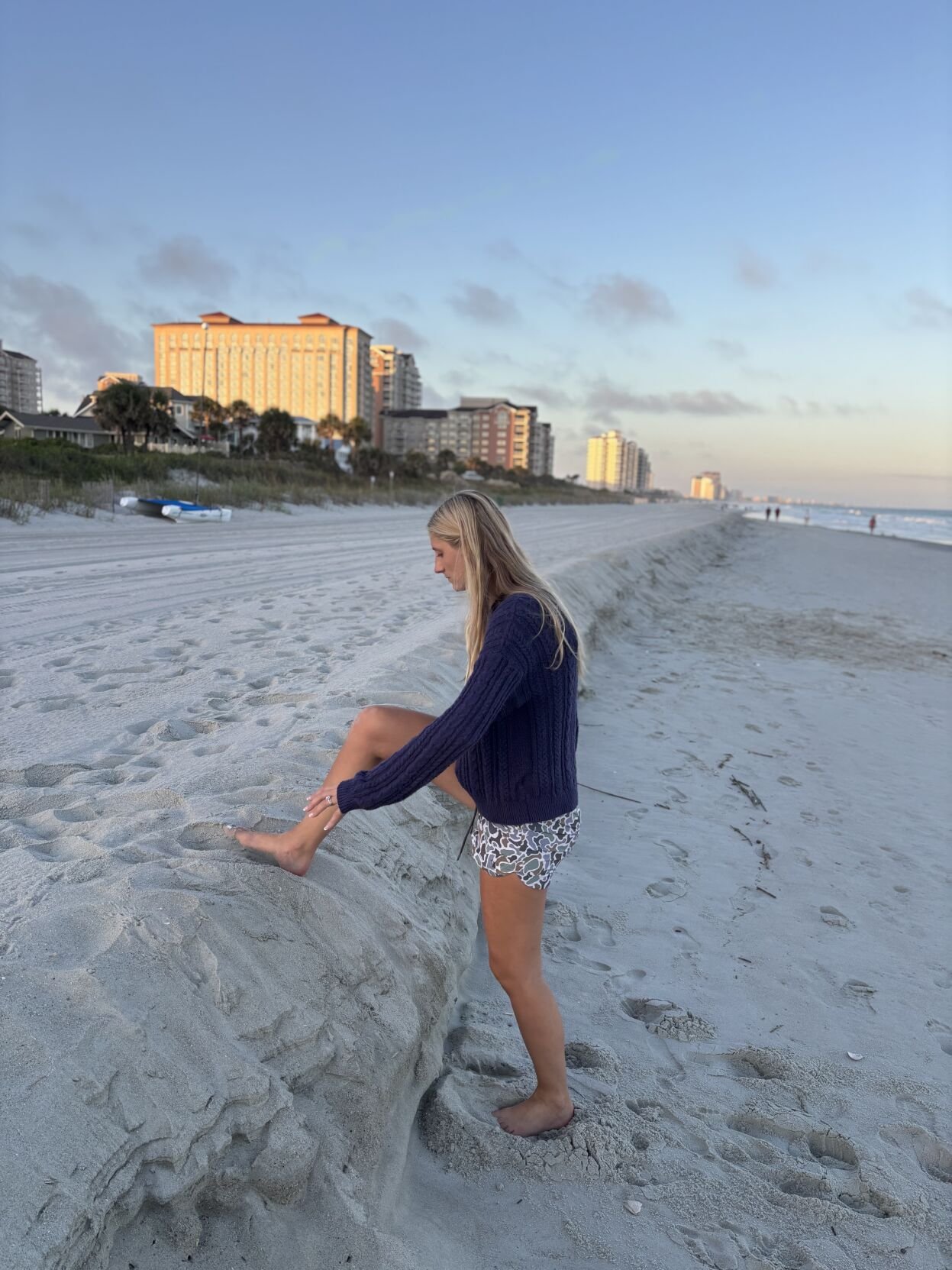Posted on October 3, 2025
With Hurricane Imelda hanging a hard right and avoiding landfall on the Carolina coast, the Grand Strand dodged potential impacts to life and property. But the storm is taking one valuable resource — sand, and lots of it.
Bringing strong waves, rip currents, high surf, heavy rains and persistent winds, Imelda is the latest tropical system to contribute to major beach erosion since the area’s last renourishment project in 2018. Beachgoers are seeing signs of escarpment, or sheer walls of sand, as well as total washouts in lower-lying areas of the Strand, but help finally is on the way.

The Cabana Shores section of Myrtle Beach is just one area of the Grand Strand showing signs of escarpment, or sheer walls of sand. The upcoming emergency beach renourishment project aims to replace 2 million cubic yards of sand starting in December.
The U.S. Army Corps of Engineers’ $72 million emergency beach renourishment project is slated to start mobilizing in October before depositing fresh sand along a 26-mile stretch of coastline in December. That’s an additional two million cubic yards of sand, or about 200,000 dump-truck loads, directly from the ocean floor.
“It’s great news for Myrtle Beach,” said USACE Charleston Division project manager Wes Wilson. “The amount of erosion that has come through since the last project is extensive due to Hurricane Ian (2022), and then Hurricane Debby (2024), so it’s exciting to get started.”
The project, contracted to the Great Lakes Dredge and Dock Company, uses temporary offshore platforms called hopper dredges to pump sand ashore and replace what has washed away over the past seven-plus years. Precipitated by hurricanes and project delays, many sections of the Grand Strand are bare below the high-tide line.
“It’s an emergency renourishment, and we really need it,” Myrtle Beach Area Chamber of Commerce President Jimmy Gray said. “It’s Mother Nature. We’re never going to keep up with her, but we have to try.”
Mother Nature and Father Time
The Thomas family has been vacationing in Myrtle Beach for decades. Their latest trip gave the western North Carolinians an unexpected taste of home — mountain-climbing on the beach.
“We’ve been coming here since the ’90s and I don’t ever remember it like this,” Deb Thomas said after scaling a 3-foot wall of sand in the Cabana Shores section of Myrtle Beach. “What happened?”
Great question, complex answer.
The same forces that create diamonds — time and pressure — also apply to beach erosion, albeit a more convoluted formula. Storms, currents, tides, reefs, elevation variations, prevailing winds, and rising sea levels all play roles in stripping sand from the shoreline over time.
Coastal Carolina University professor Dr. Paul Gayes, an expert on coastal erosion who has specifically studied the South Carolina shoreline for more than 30 years, knows this pattern all too well.
“It’s a product of the forces of nature,” Gayes said. “Beach renourishment is coming to the end of the cycle so you’re going to see steeper sloping and the beach starting to edge back into the dunes. The average (time between projects) is every eight years so it is due.”
The Grand Strand’s situation could be worse. Compared to other areas of the Carolinas’ coast that are coping with major erosion issues, like the loss of homes in the Outer Banks and tidal flooding in the Lowcountry, the Myrtle Beach area is blessed by geography — a 60-mile, semicircular stretch of sand known as Long Bay.
“The Grand Strand is fairly lucky to have a large shelf that abates erosion,” Gayes said of its location between Cape Fear to the north and Cape Romain to the south. “You’re going to lose it offshore over time due to waves, winds, currents and other factors so you have to keep maintaining that upper line.”

Faith Brown, a Myrtle Beach resident, climbs up a wall of sand near 80th Avenue in Myrtle Beach.
Digging for Sand Dollars
Beach renourishment is also a matter of simple economics: A short supply of sand could create a steep drop in demand for visitors, resulting in fewer tourism dollars for the area. An estimated 17.6 million people visit the area annually with an economic impact of $12.5 billion, according to the MBACC.
“People come here for our beaches so it’s an investment in our community’s number one asset,” Gray said. “We have great restaurants, hotels, golf … but at the end of the day people come for those big, beautiful beaches.”
With the masses visiting more for the “Beach” rather than the “Myrtle,” erosion creates a real economic dilemma: Spend millions of dollars every seven-to-10 years on sand that will eventually wash away, or watch tourism dollars do the same. However, the cost of doing nothing could be even more costly, Gray warns.
“It’s a Catch-22. Maintaining our beaches requires constant attention,” Gray said. “We have to do it every seven years or so, but if we don’t, you’re talking about a $13 billion economic impact. Tourism is the No. 2 industry in South Carolina behind agriculture so it’s critical to keep our beaches beautiful.”
Beach renourishment isn’t just about aesthetics. The sand and dunes serve as buffers for residents, both human and wildlife, and businesses along the coast, protecting life, property and infrastructure like roads and utilities. Healthy beaches are a stopgap for storm surge and inland flooding, particularly along the lower-lying areas of North Myrtle Beach/Cherry Grove Inlet to the north and Garden City/Murrells Inlet to the south.
“I’d rather see (the storms) take the sand than the beachfront homes and property,” said Wilson, citing the Strand’s valuable seaside infrastructure. “The purpose of renourishment is to reduce the risk of the loss of life and structure beyond the dunes. … The last project did what it was designed to do, but it’s time.”
Local municipalities Garden City, Myrtle Beach, North Myrtle Beach and Surfside Beach are partnering with the USACE, but the tab for this $72 million project is being fully funded at the federal level by the Coastal Storm Risk Management-program. The harsh reality is that sand and tax dollars will eventually wash out to sea, but there are no good alternatives.
“It’s an expensive, mid-term solution to a larger, long-term problem,” Gayes said. “The prevailing strategy is to think of it as a budget issue. You lose sand at a certain rate so you have to factor that in to do it every seven years … (but) we have to start having the conversation about other solutions.”
Sand through the hourglass
Wilson and his team plan to start working in early December with an estimated completion date of April 2026, weather and ocean conditions permitting.
The 26-mile project will begin in the North Myrtle Beach near Cherry Grove Inlet before moving southward to Myrtle Beach, Surfside Beach and Garden City.
Beachgoers in the affected areas will see large platforms called hopper dredges moored just offshore with a pipeline system spraying a slurry of sand and seawater from the ocean floor to the beaches. Bulldozers will spread the wet, dark sand, which is eventually dried by the wind, bleached by the sun and leveled by the tides, into layers that build up the beaches to the designed specifications.
Three-block stretches (1,000 feet) will be cordoned off for safety to keep beachgoers from getting too close to the construction zone. Local groups will work to relocate sea turtle nests and protect shorebirds and other wildlife from the heavy machinery. Not exactly a postcard-worthy scene, but the project aims to wrap before the 2026 tourism season.
Besides, some residents and visitors who hunt for seashells and sharks teeth literally follow the project’s progress. The USACE is operating an online tracker so tourists and locals will know which areas to avoid — or which ones to go to if you like to collect seashells and sharks teeth. The MBACC has compiled an information guide for those interested in the engineering feat.
“It can be fun for our visitors. Younger kids and families love seeing the equipment, and it’s great for finding shells and sharks teeth so we’re going to tap into that educational opportunity,” Gray said. “You may have a disturbance in your area for 24 hours, but that’s the beauty of Myrtle Beach; you have 60 miles to choose from.”
And starting in December, a lot more sand to relax on.

The beach renourishment project is scheduled to be completed in three phases: North Myrtle Beach (Dec. to Jan.), Myrtle Beach (Jan. to March) and Surfside/Garden City (March to April). Dates are tentative due to weather and ocean conditions






